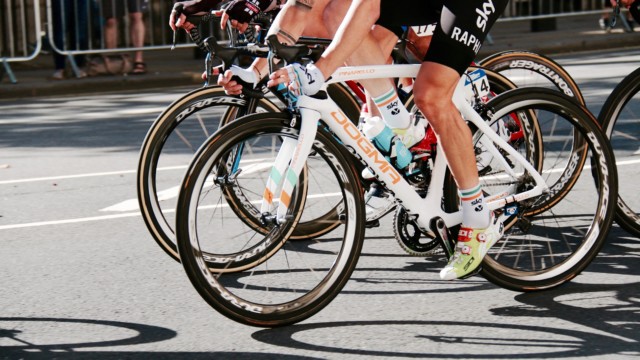Going Virtual is Not Enough, Part Two: Competitive Peer-to-Peer Events

Recently, we discussed how to reimagine traditional fundraising walks for Fall 2020 and beyond. This post will cover competitive fundraising events, such as cycling, endurance, and race events. While walks attract participation from a broad-based audience without an implicit need to be athletic, competitive events attract those with an affinity for the activity itself and those seeking to become more athletic. While there are certainly many participants who support the organization hosting the event, the cause sometimes takes a back seat to the activity itself. The community aspects of the event revolve just as heavily around the sport as the cause itself. Some participants only learn about the organization’s mission as a byproduct of participating in the athletic event.
By removing the ability to host an athletic event in the traditional sense, participants may feel they are losing the public culmination of their training efforts. In reimagining these events, we must take care to harness the essence of the competition by empowering and recognizing participants, while getting creative with building a virtual or socially distanced community, eager to take on the challenges of the activity, as well as fundraising.
Here are a few things to keep in mind while creating your reimagined competitive experience.
- Survey: The best ideas often come from those closest to the event. Volunteers, team captains, and top fundraisers are the ultimate subject matter experts, and many will take pride in offering ideas and support to help reinvent your event.
- Fundraising minimums: Many organizations choose not to enforce fundraising minimums during this time, but as on-the-ground components are added back in, the minimums will return, albeit in a reduced ways for now.
- Fundraising clubs: If there was ever a time to slim down the number of incentive levels, and simultaneously expand the remaining levels, that time is now. Choose three fundraising incentive levels and create extensive strategy around those three “clubs”. A combination of wearables, VIP treatment, mission moments, and special surprises that increase in perceived value can inspire this group of participants that are competitive in nature.
- Reallocate budget: Budget that was once spent on day-of event activities should be shifted mostly to foster participant engagement and community. Upon registration, for example, participants may have an “in training” t-shirt for the upcoming event delivered directly to their door.
- Connect participants to each other: The most successful competitive events staff spend the entire event season building community amongst participants through training rides, happy hours, fitness classes and more. Don’t let social distancing stop the fun, and keep in mind that not every community building event should be virtual. Much like the event itself, there will be some participants who are eager to get together in socially distant safe ways.
Moving Beyond Virtual – The Reimagined Competitive Event Hybrid
Much like with walks, reimagined competitive events should have at least two of three event components to be successful.
- Virtual Event Options: This option is entirely virtual and done from home or at the participant’s own pace. Using technologies such as Strava, Zwift, Boundless Motion, or the livestreaming capabilities of TeamRaiser, participants can come together on a virtual course either at the same time or separately. Though virtual, think of all the small ways you can “bring” the event to the participant, such as photoshopping finish line photos for each participant, or sending them a personalized bib or water stop supplies.
- Community-driven on-the-ground activities: These folks are nothing if not competitive and creative. Involving their own communities is a great way to make the movement stronger. Provide materials for participants to invite neighbors outside to cheer them on their way, along with an invitation to donate. Provide suggested messaging that encourages donors to give a certain amount based on number of miles it would take to run/ride by their house, setting up a donor thank you tour. There are many ways to get the community involved and ensure that the participants and teams are not going it alone. The key here is in providing not only inspiration, but materials for participants to create their own community engagement.
- Organizationally-driven on-the-ground activities: For those participants with both the desire and the ability to gather in a scaled back and socially distant manner, organizations are starting to develop modified in-person events. That could be a series of smaller gatherings that observe all appropriate safety guidelines. It could also be a publicly available route that participants can complete on their own time within a month, for example. Along the way, participants could leave each other notes, take and share selfies, communicate via a Strava or Facebook group, and celebrate their finish by posting their name and bib to a dedicated event monument that would live on throughout the event.
Ride to Defeat ALS – Massachusetts
The ALS Association Massachusetts Chapter recently announced changes to its premier cycling event, inviting team captains to create team rides across the state on September 20. Here are some highlights of their event:
- Opening ceremonies will kick off at 9:00 a.m. on Zoom and Facebook Live, followed by neighborhood rides at 9:30 a.m.
- Teams who reach a fundraising threshold will receive swag boxes filled with fun items such as noise makers, kids’ activities, and more to make this one-of-a-kind ride day experience more memorable.
- The top fundraising team will be given the honor of hosting opening ceremonies from their home or location of their choosing, which will include the arch. A member of the team will cut the starting ribbon to kick off rides across the state.
- Other fundraising incentives will include jersey and catered ride day picnics.
- Riders are encouraged to join their Strava club to track their training and ride day progress.
Challenged Athletes Foundation Community Challenge
In response to the pandemic, the Challenged Athletes Foundation created a new nationwide experience for their athletes and those who support them. The Community Challenge “empowers the dreams of challenged athletes around the world through a multi-week, multi-sport challenge to share the CAF mission, track progress, and earn premium swag, all while experiencing the impact of fundraising.” They have amped up the community aspect of the event, despite attracting a broad audience from many different locations.
- Tracking mileage using a tool called Challenge Hound, which aggregates mileage and exercise time from FitBit, Strava, MapMyFitness, Peloton, Nike+ and others.
- A robust community calendar for all participants.
- Interviews with challenged athletes available on Facebook, with 35+ interviews since the start of the pandemic.
- Motivating fundraising incentives, including my personal favorite: the ability for top fundraising teams to award a grant to challenged athlete in 2021.
- An impressive list of corporate sponsors, including presenting sponsor Vega.
In Fall 2020 and Spring 2021, large-scale in-person events should be moving beyond virtual. Organizations that reimagine their events and invent creative substitutions for safe in-person and other community events will ultimately come out on top!
To learn more about reimagining P2P campaigns during the COVID-19 pandemic, read Blackbaud’s latest eBook: Reimagining Your Peer-to-Peer Fundraising Programs: A Guide to Evolving Beyond Virtual



